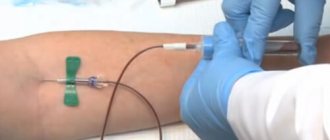.
Many people experience discomfort and anxiety while in medical institutions. Over time, these emotions result in white coat syndrome. It is expressed in the fact that a person treats doctors with anxiety, as a result of which blood pressure rises and the pulse quickens. Scientists have confirmed that more than 15% of the population has this disease. If you notice something similar in yourself that can be associated with this phobia, you should know what hypertension is and how to get rid of it.
White coat syndrome is manifested by increased blood pressure in the presence of a doctor
Description of the problem
White coat hypertension is an increase in systolic blood pressure when measured by a qualified professional. Often white coat syndrome manifests itself at the upper levels (140-160 mm Hg), the diastolic remains unchanged. The blood pressure index returns to normal after the person leaves the hospital. When measuring blood pressure in a home, familiar environment, it does not increase.
Increased blood pressure in the presence of doctors is the body's response to overexertion. In a similar way, overly susceptible people react to changes in the situation.
It is necessary to realize that the term “white coat hypertension” refers to temporary surges in pressure when visiting doctors; hypertension as an obvious disease may not exist. According to experts, white coat hypertension is a reflex acquired by a person; at the first appointment the person was under severe stress, the body remembered this reaction and now reproduces it on a subconscious level when it sees any doctor. The second name is explained by the fact that people with the syndrome react with a surge of emotions and increased blood pressure not only to the reception, but also to any other change in the situation.
White coat syndrome when measuring blood pressure
Recently, such research as 24-hour blood pressure monitoring has been increasingly used in practice. This procedure shows that patients’ cardiovascular system indicators often begin to change for the better when they find themselves outside the walls of a medical institution.
In this case we are talking about the so-called syndrome or “white coat” effect (BC). When a doctor measures blood pressure, the tonometer shows higher numbers than those detected using 24-hour monitoring in people’s usual environment.
| Features of the pathology | |
| Who is more likely to show it? | during pregnancy, in smokers, alcoholics, children, impressionable people, psycho-emotional patients. |
| How to treat | lifestyle changes, work with a psychologist, herbal medicine, proper rest, consultations with a therapist. |
| How to pass a medical examination | Taking sedatives and breathing correctly when measuring blood pressure will help. |
The term "white coat" hypertension means that a patient's blood pressure is measured only by a healthcare professional in a hospital or clinic setting.
In this situation, blood pressure levels increase significantly in some patients. Because of this, the doctor may mistakenly diagnose “arterial hypertension.” Increased blood pressure during the presence of a medical professional is largely due to the patient's anxiety and excitement.
During diagnosis at home, reactions of anxiety and excitement are less pronounced. Blood pressure readings are within the normal range.
Causes of pressure surges
This phenomenon has not yet been fully studied, but most scientists are confident that this is how the body reacts to a stressful situation.
A tendency to such a syndrome is usually observed in people with increased anxiety and suspiciousness.
They have instability of the vascular wall. The “white coat” effect is reminiscent of a fear of dentists or any other fears during which changes occur in the body. For example, sweating occurs, breathing is held, blood pressure rises, heart rate increases, etc.
In children susceptible to this symptom, the increase in blood pressure becomes more significant in the future! In some cases, the formation of hypertension is likely. The risk of developing cardiovascular diseases in the future is much higher in people who are prone to HD hypertension.
A study conducted by foreign scientists revealed that about 40% of the total population is susceptible to the classic syndrome of high blood pressure when visiting a doctor.
People who experience this condition frequently should take action and normalize their condition. This will reduce the risk of cardiovascular diseases in the future and save you from stroke.
Symptoms of pathology
During a diagnosis by a doctor, a person’s blood pressure often rises and their pulse often quickens. The patient's condition becomes anxious, distracted and agitated. After connecting ECG, tonometer or ultrasound suction cups to his body, his cheeks may turn red, he may begin to sweat excessively, and may develop a cough.
It is noteworthy that in this condition the patient’s only tonometer readings go off scale. The lower numbers usually remain within normal limits.
It has been noticed that patients experiencing fear, anxiety and similar sensations at a doctor’s appointment have indicators in the top numbers on the tonometer of 150 mm Hg. After the patient leaves the medical facility and finds himself in a familiar and calm environment, the pressure readings immediately stabilize.
The “white coat” effect affects mainly insecure, emotional and very impressionable people. In rare cases, these may be individuals with hidden mental disorders, drug addicts or experienced smokers.
Risk group
Most often, white coat hypertension is observed in impressionable individuals. What makes them nervous is that they take going to the doctor to heart. Also at risk are individuals who are weak in spirit. People with mental disorders also fall into this group; their fear of medical workers is more obvious and can lead to a panic attack.
In addition, people who lead an unhealthy lifestyle and have bad habits are at risk.
It is important to note that the syndrome can manifest itself in children one year old and older (children under one year old quickly forget everything) - this is most often associated with a child’s bad experience: without warning, blood was taken from a finger, and a painful injection was given.
These negative emotions are a source of anxiety.
Possible consequences of the disease
Enter your pressure
130
on
90
Search in progress Not found
When pressure begins to increase, it can be episodic in nature, and does not harm a person’s health. Blood tests of patients who suffer from white coat hypertension have determined a strong increase in cholesterol and sugar. Such symptoms occur when a person has diabetes. If the symptoms of a sudden and sharp increase in blood pressure are not treated, they will develop into pathology and can lead to consequences:
- left ventricle enlargement;
- the appearance of kidney diseases;
- stroke due to stress;
- When measuring pressure, the readings are high:
- during pregnancy, this phenomenon has a bad effect on the unborn child;
- for older people, the disease can become a serious threat to life;
- People who do not lead a healthy lifestyle are often susceptible to mental disorders and can develop severe hypertension.
White coat hypertension may lead to serious heart disease
Symptoms
Like any other disease, white coat syndrome has its symptoms. The symptomatic picture will allow you to determine whether it is simple anxiety or a problem that requires treatment. Let's move on to the symptoms:
- increased blood pressure when measured in hospital;
- Blood pressure normalizes after the end of the doctor’s appointment;
- disjointed speech, panic attacks;
- increased pulse and difficulty breathing when visiting a doctor; trembling in the arms and legs is also possible.
News on white coat hypertension
Read more
To make a correct diagnosis, blood pressure should be measured at home, in a gown.
High blood pressure is one of the main risk factors for such deadly diseases as myocardial infarction and stroke. Arterial hypertension or high blood pressure has long become one of the “diseases of the century,” which are characterized by both the widespread nature of the disease and the danger to the patient’s life. For this reason, doctors around the world tirelessly remind people of the need to control blood pressure and regularly take medications for hypertension. However, Spanish doctors urge colleagues not to rush into making such a diagnosis based on blood pressure measurements, even repeated ones, taken in a hospital setting - the patient must determine the blood pressure reading at home. Many patients diagnosed with arterial hypertension, in fact, have no trace of it.
Read more
Fear of the white coat can lead to many false diagnoses
Arterial hypertension or high blood pressure has long become one of the “diseases of the century,” which are characterized by both the widespread nature of the disease and the danger to the patient’s life. High blood pressure is one of the main risk factors for such deadly diseases as myocardial infarction and stroke. For this reason, doctors around the world tirelessly remind people of the need to control blood pressure and regularly take medications for hypertension. However, British doctors urge their colleagues not to rush into making such a diagnosis based on pressure measurements, even repeated ones, taken in a hospital setting - the patient must determine the pressure reading at home. Many patients diagnosed with arterial hypertension, in fact, have no trace of it.
Read more
The diagnosis of hypertension should only be made after monitoring blood pressure at home
In the UK, for the first time since the introduction of blood pressure measuring devices into the arsenal of doctors, indicators obtained during an examination in a doctor’s office will no longer be the basis for making a diagnosis. For accuracy, blood pressure must be measured at home.
Read more
Why Blood Pressure Shouldn't Just Be Measured in the Doctor's Office
Nowadays, therapists have dozens of different drugs for the treatment of arterial hypertension in their arsenal. But scientists strongly recommend not to rush into taking such medications, even if the blood pressure was found to be elevated when measured in the doctor’s office.
Diagnostics
In order to begin to treat a phobia, it is necessary to correctly diagnose the disease. If attacks of arterial hypertension are very rare and appear only after stressful situations, then there is no need for their treatment. In order to record the exact number of pressure surges and their frequency, a person is recommended to measure blood pressure daily, in the morning and in the evening, and record the results in a special journal, which should be taken with you to subsequent visits to the doctor.
To detect the risk of cardiovascular diseases, it is important to determine whether there are disturbances in the functioning of target organs (these are the organs that suffer most from pressure changes: kidneys, heart, brain, eyes) and identify the diseases accompanying them. To do this, you should undergo diagnostics, including the following tests and examinations:
- lipid profile;
- blood sugar test;
- analysis for the level of uric acid in the blood;
- clinical laboratory tests;
- electrocardiography (ECG);
- echocardiography;
- Ultrasound of the kidneys;
- Ultrasound duplex scanning of the carotid arteries.
What is it and how does it manifest itself?
Visiting a clinic is not a pleasant experience, which is why everyone experiences negative emotions when visiting a doctor. But there is a certain category of people who are most susceptible to circumstances. White coat syndrome is a term that refers to an increase in blood pressure during blood pressure measurement. For many, it manifests itself in a sharp jump in indicators from just one sight of a man in white. Having crossed the threshold of the hospital, people cannot cope with internal anxiety, which develops into a painful state of hypertension. Science has identified this manifestation as a separate section of medicine and subjected it to careful study. How to treat white coat syndrome if hypertension is caused by the person who is supposed to treat it? After all, as soon as the patient finds himself in a familiar home environment, he feels great... This paradoxical and specific phenomenon causes concern, since the manifestation of a painful condition is not as harmless as it might seem at first glance.
Fighting the syndrome
Some people are confident that such a psychological reaction is not a disease and does not require treatment, but experts believe that this problem cannot be neglected: against the background of constant stress, the syndrome can lead to an enlargement of the left ventricle of the heart or the development of kidney problems. The following are recommendations for the treatment and prevention of white coat hypertension.
- All people who have discovered white coat syndrome need to stabilize their lifestyle. To do this, you need to quit smoking, not abuse alcohol, eliminate it if possible, switch to proper nutrition, and devote a sufficient amount of time to physical activity.
- Various methods of autogenic training and sessions with a psychotherapist do an excellent job of combating this syndrome. If hypertension continues to develop and attacks in hospitals become more frequent, it is recommended to consult a specialist to obtain medications.
- Some patients note significant improvements after taking sedatives, antidepressants, or traditional medicine that are aimed at stabilizing the nervous system.
- It is also possible to use diuretics to reduce blood pressure by ridding the body of excess water and salts.
Causes
Almost 20% of the population suffering from hypertension has white coat syndrome. The most common reason is fear that arises in a person. Most people suffer from the fear of hearing a bad prognosis for their health or a bad diagnosis.
Today, the Internet is making the situation worse by providing endless resources on various disease conditions.
However, in the absence of proper medical knowledge or guidance from a trained medical professional, people tend to be misled by reading negative advice or comments about the disease in question.
Psychologists associate fear of doctors with the general association of hospitals with illness, injury, and death.
The second reason is the fear of needles and injections. Needle phobia is a recognized disorder, listed in ICD 11 under phobias for blood, injections, and injury. People who suffer from this phobia begin to experience anxiety, fainting, and panic attacks at the sight of a needle.
Almost 10% of the population has such a phobia. In a recent study from Switzerland, the syndrome was associated with age. Other factors such as family history, physical activity are not significant factors.
Passing a medical examination
Many people are afraid to undergo a commission due to white coat syndrome. Most often, this is the fear that the doctor will write out a false diagnosis based on the results of the examination. In order to get rid of white coat syndrome and successfully pass the medical examination, you should follow these tips:
- be sure to inform the medical staff about your syndrome, the doctor is not your enemy and will always help;
- before visiting the doctor, experts recommend taking sedative pills that will help you calm down before visiting the hospital;
- On the way to the examination, set yourself in a positive mood; listening to your favorite music will help.
To prevent the sight of a hospital from triggering a surge in blood pressure, you should take a sedative.
Story
This phenomenon was first noticed in 1897 by Riva Rocchi. There is a difference in terms, syndrome and effect. White coat syndrome is an increase in blood pressure in the doctor's office. The effect indicates changes that occur before the clinic visit, during the clinic visit, and after the doctor visit. Observed in patients diagnosed with hypertension.
In 1983, Mancia et al. quantified changes in people's blood pressure before, during, and immediately after a doctor's visit. The results of the study showed that it is an important condition observed in the majority of patients of all age groups and genders from children to the elderly.
The incidence rate is approximately 20% of the total population suffering from hypertension. It is more often observed in women compared to men. Occurs in pregnant women, the incidence rate ranges from 3% to 60%. The wide range is based on the results of three different clinical studies.
It is noted that white hypertension in pregnant women is a mild, benign symptom and does not cause complications such as preeclampsia.
Women may be inclined to have a cesarean section during labor based on high blood pressure readings taken at the time. A review article by Verdecchia et al states that an individual may be diagnosed if the pressure is equal to or greater than 140/90 mmHg. during the clinical visit, while the regular remains below 135/85 mmHg. All the rest of the time.
Find out more Spinal shock - Brown-Séquard syndrome, mechanisms of occurrence
Diagnosis and treatment
How to get rid of white coat syndrome? First of all, it is necessary to carefully monitor pressure indicators. This procedure can be done independently at home, or you can use a special device that, outside the medical walls, timely marks the pressure norm in automatic mode. A prerequisite is to undergo a number of tests. Yes, you need:
- donate blood for cholesterol and check your lipid profile;
- determine blood sugar levels;
- submit urine for laboratory tests;
- undergo a full examination with determination of general clinical indicators;
- visit a cardiologist;
- undergo an ultrasound examination of the kidneys and heart.
If concomitant pathologies are detected, the patient is prescribed complex treatment and supportive care. One form of rehabilitation is a course of classes and conversations with a psychologist. Often it is auto-training that helps patients cope with their condition.
Preventive measures
Many people are interested in the question of how to deal with white coat syndrome? The answer from experts is this: it is important to prevent the development of the disease. A standard set of measures for a healthy life is:
- giving up all bad habits (smoking, alcohol abuse, etc.);
- transition to proper nutrition: all food should have a balanced composition and not contain a large amount of fat;
- emotional stability training under the supervision of a qualified psychologist; various self-control techniques help increase self-confidence and get rid of the fear of the hospital atmosphere;
- restraining excessive emotionality;
- normalization of motor activity;
- taking sedatives as prescribed by a doctor.
- Pregnant women need to be under constant supervision of a psychologist.
These activities will help keep blood vessels toned and the heart in order. Many patients use traditional medicine methods for recovery (herbal decoctions, infusions). But all decisions must be made in agreement with a specialist in order to avoid possible problems in the future.
How to overcome the fear of white coats
If you realize that specific doctors scare you, try to find other specialists. You can even seek help from a private clinic where the best professionals work. It is thanks to experienced, skillful, knowledgeable doctors that it is possible to overcome the patient’s fear of dentists, gynecologists, proctologists and other “scary” doctors.
Do not hesitate to ask friends and relatives about the services of which doctors they use. This will help you determine which specialists are worth going to and which ones are not.
Often, the fear of a white coat is associated with a fear of medical procedures. If you are having treatment, ask your doctor to tell you in detail how you will feel and how long it will last. According to the observation of psychologists, clear instructions are calming, while the unknown is frightening.









